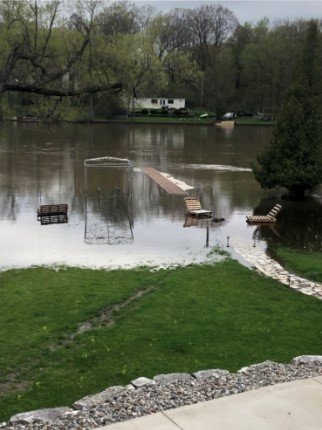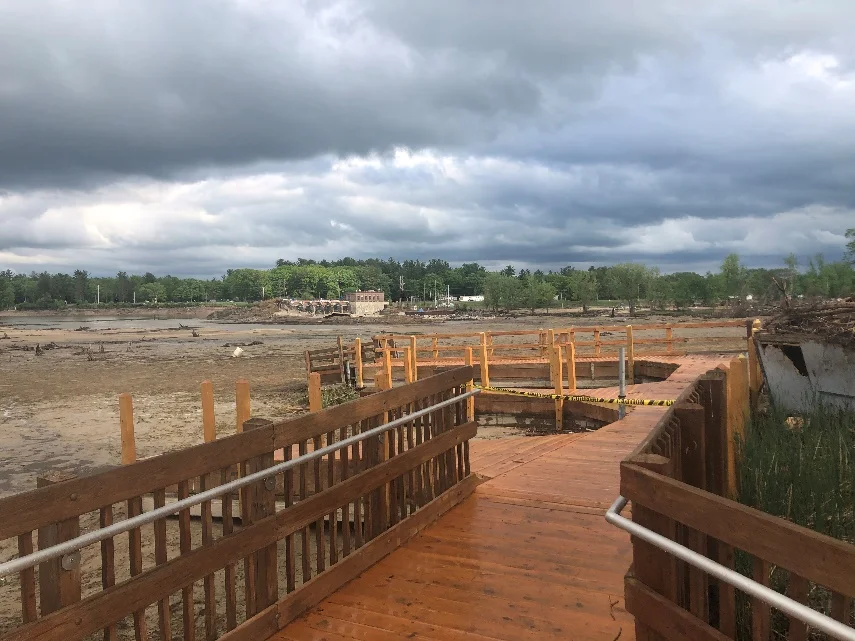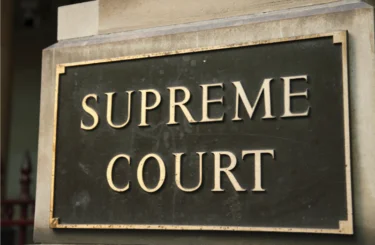
Michigan Court of Appeals Issues Decision For Midland Dam Flooding Lawsuits
Recently the Michigan Court of Appeals issued a decision on a series of lawsuits brought by property owners against the State of Michigan – Department of Environment, Great Lakes, and Energy (EGLE) – for its role in the Midland dam flooding event of 2010. A series of hydropower dams in Mid-Michigan had fallen into a state of disrepair for years and the owner of the dams lost his license to operate them. The state of Michigan took them over and fought to maintain high water levels despite clear warnings that the dams could not sustain a series water event, like a heavy rain storm. In May of 2020 the inevitable happened when a series rain storm occurred and the water that fell caused the already burdened dams to fail, and one of the state’s worst flooding events to unfold.

What was once beautiful waterfront property along Wixom Lake was first flooded, and then as the water receded, left without a lake.


The event drew national media attention and it is among the worst examples of Michigan governmental officials harming their own citizens in the state’s history.
The property owners affected by the terrible flooding event, include homeowners, businesses and renters who lost their homes or businesses due to the event. Hundreds of them filed lawsuits against the state, including a class action lead by clients of Sommers Schwartz and partner Jason J. Thompson. The basis for the lawsuits is found in constitutional law, namely, that by their acts and omissions, having the effect of requiring the water levels to remain high when warning after direr warning had been given, reinforcing what everyone knew: that the dams were in a state of disrepair and could not withstand any serious water event, The State of Michigan effectively condemned the property owners to losing their property. The technical name for the legal theory is “inverse condemnation” and it is based on each citizen’s constitutional right under the Fifth Amendment to the United States Constitution and the same protection under the Michigan Constitution. US Const, Am V; Const 1963, art 10, § 2.14. As the Court of Appeals explained:
Inverse condemnation is “a cause of action against a governmental defendant to recover the value of property which has been taken . . . even though no formal exercise of the power of eminent domain has been attempted by the taking agency.” Mays, 506 Mich at 173 (cleaned up). As alleged in this case, “[i]nverse condemnation can occur without a physical taking of the property; a diminution in the value of the property or a partial destruction can constitute a ‘taking.’” Merkur Steel Supply Inc v Detroit, 261 Mich App 116, 125; 680 NW2d 485 (2004). For instance, “[i]t is well settled that a governmental actor may cause a taking of private property by flooding the property or diverting excess surface water onto the property.” Wiggins v City of Burton, 291 Mich App 532, 572; 805 NW2d 517 (2011). “Generally, a plaintiff alleging a de facto taking or inverse condemnation must establish (1) that the government’s actions were a substantial cause of the decline of the property’s value and (2) that the government abused its powers in affirmative actions directly aimed at the property.” Blue Harvest, Inc v Dep’t of Transp, 288 Mich App 267, 277; 792 NW2d 798 (2010). See also Charles Murphy, MD, PC v Detroit, 201 Mich App 54, 56; 506 NW2d 5 (1993) (“While there is no exact formula to establish a de facto taking, there must be some action by the government specifically directed toward the plaintiff’s property that has the effect of limiting the use of the property.”).
The lawyers representing the property owners intentionally selected the inverse condemnation claim under the Michigan Constitution because it is not subject to dismissal under the doctrine of governmental immunity, which could have applied and insulated the State of Michigan from liability under other legal claims, such as negligence. The State of Michigan however filed a request for the trial court to dismiss all the lawsuits, arguing that all of them did not plead facts that supported an inverse condemnation claim. The trial court rejected the State’s argument, and the State immediately appealed the decision.
Sommers Schwartz partner David R. Parker was instrumental in briefing and in preparing for oral argument in this appeal, which is the latest in a series of appeals the State has initiated since shortly after the cases were filed in 2020. After dispensing with some procedural issues concerning the standard of review, the Court of Appeals turned its attention to the question of whether the property owners had sufficiently pleaded a case under the law for the State’s taking of their property without compensation. Mr. Parker explained that the State offered two primary arguments: (1) the State did not take affirmative actions directly aimed at plaintiffs’ properties and (2) plaintiffs’ property was not put to a public use.
With respect to the first argument, the Court of Appeals held that plaintiffs did identify several affirmative actions taken by the State of Michigan that arguably contributed to the water event, including knowing about the Edenville Dam’s inability to withstand significant rainfall because of insufficient spillway capacity and knew that the dam’s poor conditions posed a danger to the surrounding area and properties; actively prevented efforts to repair the dam and threatened enforcement actions if the water levels were drawn down; and concealing the risks posed by the dam and raise the lake levels to dangerous levels because it was more concerned with protecting environmental conditions in the lake. Specific examples of the active conduct included authorizing the prior owner to raise water levels just weeks before the rain and issuing several public comments dated back to 2018 that the dam was structurally sound, despite knowing it was not. The Court of Appeals noted the plaintiff lawyers’ description of these factors as “defendants’ affirmative actions ‘set into motion the destructive forces’ that caused the dam failure and the damage to plaintiffs’ properties that were in the direct line of harm.” The Court drew parallels between the Midland Dam case and another recent back-eye event for Michigan government officials, the Flint Water Crises case, where the same legal theory, active government failures and later attempts by government lawyers to avoid responsibility all took place. Mays v Governor, 506 Mich 157, 172-173; 954 NW2d 139 (2020).
Our Supreme Court’s recent decision in Mays, which involved the Flint water crisis, is highly instructive. Just as here, the Mays Court analyzed whether the plaintiffs adequately pleaded inverse condemnation to overcome a motion for summary disposition under MCR 2.116(C)(8). Mays, 506 Mich at 172-180. The plaintiffs in Mays alleged damages arising from the defendants servicing their property with toxic water from the Flint River. Id. at 170-171. The Court held that the plaintiffs’ allegations, taken as true, were sufficient to state an inverse condemnation claim on which relief could be granted. Id. at 179. Most relevant here, the Court rejected the defendants’ position that the plaintiffs had not sufficiently alleged affirmative actions by the defendants that were directed at the plaintiffs’ properties. Id. at 174-175.
Lastly, the Court rejected the State’s argument that it never took the property owners property for “public use” and noted that there is no history of a flooding case, public use and inverse condemnation under the Michigan Constitution, like this one.
Traditionally, the question of “public use” under Article 10, § 2 of the Michigan Constitution arises when the government seeks to use its power of eminent domain to take private property. Outside of this context, Michigan courts have not squarely addressed when affirmative actions taken by the state that have downstream effects aimed at private properties constitute a taking for “public use.” Indeed, most inverse condemnation cases, including ones involving government-induced flooding, mention public use only in passing. See, e.g., Wiggins, 291 Mich App at 571; Marilyn Froling Revocable Trust, 283 Mich App at 296.
The Court rejected the State’s invitation to consider the public use question from the perspective of the property owners real property, which the State argued, was not put to pubic use. Instead, the Court of Appeals accepted Plainitffs contention that it was the State’s control and effective operation of the dam before that constituted pubic use of property.
Analogizing to Hathcock, the relevant question is whether defendants took plaintiffs’ property by controlling the operation of the dam for a public use, not whether plaintiffs’ property—once taken—would be put to a public use. See id. at 475-476. Plaintiffs alleged that defendants pressured Boyce to keep water levels high to protect aquatic life, prioritizing that interest at the expense of the safety of people and property. Accepting these allegations as true, they suggest that defendants, through their operational control of the dam, put the dam to a public use in their pursuit of environmental protection. Therefore, plaintiffs have sufficiently pleaded that defendants’ alleged taking of their private property constituted a public use for which plaintiff are entitled to just compensation.
Jason J. Thompson
Jason Thompson is a nationally board certified trial attorney and co-chairs Sommers Schwartz’s Complex Litigation Department. He has a formidable breadth of litigation experience, including class action and multidistrict litigation (MDL), and practices nationwide in both state and federal courts.





